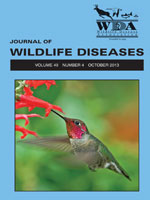White-nose syndrome (WNS) is an emerging infectious wildlife disease that has killed more than 5 million bats in the eastern United States since its discovery in winter 2006. The disease is associated with a cold-adapted fungus that infects bats during winter hibernation. Wing damage has been documented in bats with WNS and could become a useful screening tool for determining whether samples should be submitted for testing. However, because there are no historic records, to our knowledge, of wing damage before the emergence of WNS, it is unknown what types of grossly observable wing damage, if any, are specific to WNS. To address this knowledge gap, we inspected the wings of 1,327 bat carcasses collected in Illinois from 2005 and 2008–2010, then used Akaike information criterion to evaluate generalized linear models of the frequencies of different categories of wing damage using age, sex, year, and season as predictors in big brown bats (Eptesicus fuscus). Wing discoloration was best predicted by year and season. There were no clear predictors for other categories of wing damage. We found that about one-fourth of big brown bats surveyed from this presumptive WNS-negative sample had moderate or severe wing damage. We encourage further studies of the relationship between WNS and wing damage to better understand which categories of damage are to be expected in the absence of WNS in susceptible species.
How to translate text using browser tools
1 October 2013
TEMPORAL VARIATION IN BAT WING DAMAGE IN THE ABSENCE OF WHITE-NOSE SYNDROME
Lisa E. Powers,
Joyce E. Hofmann,
Jean Mengelkoch,
B. Magnus Francis
ACCESS THE FULL ARTICLE

Journal of Wildlife Diseases
Vol. 49 • No. 4
October 2013
Vol. 49 • No. 4
October 2013
Akaike Information Criterion
Eptesicus fuscus
Generalized linear model
Geomyces destructans
wing damage index




